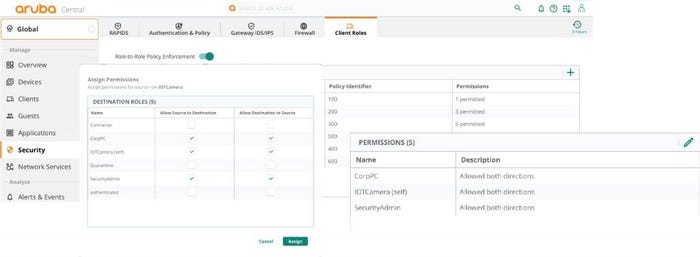Aruba Makes ESP Advancements to Keep Up with Changing Business Requirements
Updates deliver cloud-native services to automate and accelerate the deployment/protection of edge-to-cloud networks.
March 29, 2022

ARUBA ATMOSPHERE — Aruba (an HPE company) has made significant upgrades to Aruba ESP (Edge Services Platform). These advancements include new functionality in Aruba Central to give organizations the ability to keep pace with rapidly changing business requirements.
The news comes in conjunction with Aruba’s Atmosphere ‘22 conference in Las Vegas. Channel Futures is there.

Aruba Central NetConductor
The new Aruba Central NetConductor aims to allow enterprises to centralize the management of distributed networks with cloud-native services. These are services that simplify policy provisioning and automate network configurations in wired, wireless, and WAN infrastructures. Central NetConductor enables a more agile network while enforcing zero trust and SASE security policies.
Here’s our most recent list of new products and services that agents, VARs, MSPs and other partners offer. |

Aruba’s Larry Lunetta
“Aruba is introducing new network modernization solutions built on Aruba ESP,” said Larry Lunetta, vice president of solutions portfolio marketing at Aruba. “Aruba Central NetConductor is the first cloud-native, standards-based solution that delivers a unified network overlay (fabric) across wired, wireless, and WAN infrastructure at global scale. This enables network professionals to automate fabric configuration and management with workflows tied to business intent. It also enables implementation of identity-based security that is enforced in-line by the network infrastructure. This is foundational for zero trust and SASE architectures.”
Self-Locating Indoor Access Points
Aruba also revealed self-locating indoor access points (APs) with built-in GPS receivers and Open Locate. These are a proposed new industry standard for sharing location information from an access point to a device.
“The new self-locating access points that include GPS receivers are revolutionizing location applications,” said Lunetta. “They do this by filling in the final gap in indoor location data by using the fixed location framework of GPS to accurately anchor location reference points and eliminate manually induced errors.”
Traditional approaches, such as Bluetooth ranging, do not have a fixed frame of reference and use manual mapping, according to Lunetta. So the data is less accurate, often by multiple meters. With one meter or less accuracy, GPS-based location data opens up new applications such as wireless access points self-locating on a map and now makes practical line-of-business solutions such as wayfinding, asset tracking and space utilization.
Benefits to Partners
These innovations, along with Aruba’s network-as-a-service (NaaS) offerings, will benefit their partners and the channel in terms of business requirements. They will do this in three significant ways, allowing them to:
Tap into customer strategic digital acceleration and network modernization initiatives with new, unique solutions.
Build a recurring revenue stream by accelerating customer migration to the cloud.
Deliver additional services to help customers adopt new technologies and provide them in a NaaS offering.
The need for more agile, flexible networks has been mounting, driven by the digital transformation accelerated by the pandemic.
Aruba’s cloud-native services deal with the complexity of multi-generational architectures with their attendant operations. They also deal with security challenges. Traditional VLAN-based architectures require significant manual configuration and integration; therefore, they are slow to adapt to new business connectivity requirements, causing potential security gaps, the company said.
A modern, agile network closes this gap. It employs a network overlay that seamlessly stitches together existing VLAN segments with cloud-native policy and configuration services. This enables users and devices to make secure and reliable connections from anywhere. To help customers accelerate digital transformation initiatives, Central NetConductor uses AI for management and optimization. It also implements business-intent workflows to automate network configuration, and extends Aruba’s built-in security with …
… cloud-native network access control (NAC) and dynamic segmentation for fabric-wide enforcement. Because Central NetConductor is based on widely accepted protocols such as EVPN, VXLAN and BGP, it can be adopted seamlessly, Aruba said, that preserves investments based on the ability to operate with existing Aruba networks and third-party vendor infrastructures.
Digital Acceleration Driven By Remote/Hybrid Work
“Hybrid work focuses on both remote work and return to office,” said Lunetta. “For remote work, the goal is to provide the identical user experience, management and security. This whether it is on or off the campus. Aruba Central NetConductor enables organizations to integrate workers in the home or on-the-go into a single, unified view and point of control via Aruba Central. This includes both automated network configuration and management for now hundreds of thousands of endpoints and universal identity-based access control. This is the foundation for zero trust and SASE security frameworks.”
As organizations redesign and refresh campus offices in keeping with business requirements, wireless connectivity continues to evolve. The need for higher bandwidth for applications such as video collaboration has become paramount. From an agility perspective, organizations can start to introduce the latest Wi Fi 6E Aruba access points alongside existing infrastructure. With this, they can begin to take advantage of the higher performance and automated self-location without obsoleting their current investment.

Lopez Research’s Maribel Lopez
“In today’s business world, flexibility is paramount,” said Maribel Lopez, founder of Lopez Research. “Enterprises need to be able to shift gears, turn up new services and offerings, and serve new customers seemingly overnight. Because the network underpins everything – enabling critical connectivity and data-driven intelligence – it’s got to have the flexibility built-in. Organizations today should look for standards-based solutions that give them technical flexibility and the ability to protect their investments and adopt new technologies at their own pace, but also options when it comes to consumption models.”
Automate the Deployment of the WLAN
WLAN access point installation is a manual, error-prone and time-consuming process. This often results in an unreliable reference for location-aware applications. Aruba has introduced self-locating indoor access points to address this. The idea is to simplify how organizations capture indoor location data and communicate information over the air to any mobile device or application.
Aruba Wi-Fi 6 and Wi-Fi 6E APs with built-in GPS receivers and intelligent software enable accurate, automated WLAN deployments. Aruba’s self-locating WLAN APs provide zero-touch determination of AP location. They also continuously validate and update location. Lastly, they provide a set of universal coordinates that can be transposed on any floor map.
Accurate location of the WLAN infrastructure generates an anchored reference that is shared using Open Locate. Businesses are able to then utilize the universal coordinates and anchored reference of Aruba’s self-locating indoor access points. They do this to develop or enhance asset tracking, safety/compliance, facility planning, venue experience apps or other location-aware services.
Changing Business Requirement and Evolving Approaches

Aruba’s David Hughes
“Enterprises have shown tremendous resiliency in the face of major disruptions and tectonic shifts within their businesses over the past two years, and it’s become clear that business agility is now top-of-mind for our customers,” said David Hughes, chief technology and product officer at Aruba. “The advancements introduced today will help customers evolve their approach to a ‘services orientation’ using AI-powered solutions, strengthening security and accelerating the move to a cloud-centric network architecture, which are all hallmarks of a modern network.”
These new solutions are available via traditional procurement and deployment methods or as a service through HPE GreenLake for Aruba networking. This hands customers the flexibility to adjust their networking needs in accordance with their business requirements. The latest enhancements to HPE GreenLake for Aruba network as a service (NaaS) include eight standardized offerings designed around popular enterprise networking use cases, providing greater simplicity and accelerating time-to-value for NaaS deployments.
Want to contact the author directly about this story? Have ideas for a follow-up article? Email Allison Francis or connect with her on LinkedIn. |
About the Author(s)
You May Also Like


